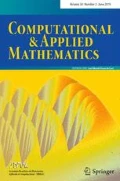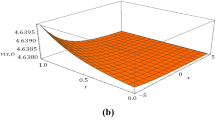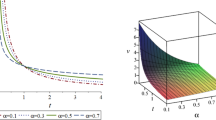Abstract
In this paper, we investigate the time fractional system of fluid-conveying single-walled carbon nanotube (SWCNT), the generalization of SWCNT system which plays important roles in many applied fields. The corresponding Lie symmetries admitted by this fractional system in Riemann–Liouville sense are obtained and symmetry reductions are performed. In addition, based on the above symmetries, the conservation laws are derived using new Noether theorem. Furthermore, analytical solution and numerical series solution to the initial value problem of time fractional SWCNT system in Caputo sense are constructed by applying invariant subspace method and q-homotopy analysis method, respectively.





Similar content being viewed by others
References
Bin Z (2012) G’/G-expansion method for solving fractional partial differential equations in the theory of mathematical physics. Commun Theor Phys 58(5):623–630
Chang WJ, Lee HL (2009) Free vibration of a single-walled carbon nanotube containing a fluid flow using the Timoshenko model. Phys Lett A 373(10):982–985
Choudhary S, Daftardar-Gejji V (2017) Invariant subspace method: a tool for solving fractional partial differential equations. Fract Calc Appl Anal 20(2):477–493
Choudhary S, Daftardar-Gejji V (2019) Solving systems of multi-term fractional PDEs: invariant subspace approach. Int J Model Simul Sci Comput 10(1):1941010(25p)
Diethelm K (2010) The analysis of fractional differential equations. Springer, New York
EI-Tawil MA, Huseen SN (2012) The Q-homotopy analysis method (Q-HAM). Int J Appl Math Mech 8(15):51–75
Galaktionov V, Svirshchevskii S (2006) Exact solutions and invariant subspaces of nonlinear partial differential equations in mechanics and physics. Chapman and Hall/CRC, Boca Raton
Gazizov RK, Kasatkin AA (2013) Construction of exact solutions for fractional order differential equations by the invariant subspace method. Comput Math Appl 66(5):576–584
Gazizov RK, Kasatkin AA, Lukashchuk SY (2007) Continuous transformation groups of fractional differential equations. Vestnik Usatu 9:125–135
Gazizov RK, Kasatkin AA, Yu S (2009) Lukashchuk, Symmetry properties of fractional diffusion equations. Phys Scr 136:014–016
Guo BL, Pu XK, Huang FH (2015) Fractional partial differential equations and their numerical solutions. Science Press, Beijing
Horstman D (2002) On the existence of radially symmetric blow-up solutions for the Keller-Segel model. J Math Biol 44(5):463–478
Huang Q, Zhdanov R (2014) Symmetries and exact solutions of the time fractional Harry-Dym equation with Riemann-Liouville derivative. Phys A 409:110–118
Ibragimov NH (2007) A new conservation theorem. J Math Anal Appl 333(1):311–328
Ibragimov NH, Avdonina ED (2013) Nonlinear self-adjointness, conservation laws, and the construction of solutions of partial differential equations using conservation laws. Russ Math Surv 68(5):889–921
Inc M, Yusuf A, Aliyu AI, Baleanu D (2018) Time-fractional Cahn–Allen and time-fractional Klein–Gordon equations: lie symmetry analysis, explicit solutions and convergence analysis. Phys A 493:94–106
Inc M, Yusuf A, Aliyu AI, Baleanu D (2018) Lie symmetry analysis, explicit solutions and conservation laws for the space-time fractional nonlinear evolution equaitons. Phys A 496:371–383
Iyiola OS (2013) A numerical study of ito equation and Sawada–Kotera equation both of time-fractional type. Adv Math Sci J 2(2):71–79
Iyiola OS, Ojo GO (2015) On the analytical solution of Fornberg–Whitham equation with the new fractional derivative. Pramana J Phys 85(4):567–575
Iyiola OS, Olayinka OG (2014) Analytical solutions of time-fractional models for homogeneous Gardner equation and non-homogeneous differential equations. Ain Shams Eng J 5:999–1004
Jaber KK, Ahmad RS (2018) Analytical solution of the time fractional Navier–Stokes equation. Ain Shams Eng J 9:1917–1927
Liu HZ (2013) Complete group classifications and symmetry reductions of the fractional fifth-order KdV types of equations. Stud Appl Math 131:317–330
Liu HZ, Geng YX (2013) Symmetry reductions and exact solutions to the systems of carbon nanotubes conveying fluid. J Differ Equ 254(5):2289–2303
Liu WH, Zhang YF (2019) Time-fractional Drinfeld–Sokolov–Wilson system: lie symmetry analysis, analytical solutions and conservation laws. Eur Phys J Plus 134(3):126
Liu HZ, Wang ZG, Xin XP, Liu XQ (2018) Symmetries, symmetry reductions and exact solutions to the generalized nonlinear fractional wave equaitons. Commun Theor Phys 70(7):14–18
Lu B (2012) The first integral method for some time fractional differential equations. J Math Anal Appl 395:684–693
Lukashchuk SY (2015) Conservation laws for time-fractional subdiffusion and diffusion-wave equations. Nonlinear Dyn 80:791–802
Majlesi A, Ghehsareha HR, Zaghian A (2017) On the fractional Jaulent-Miodek equation associated with energy-dependent Schrödinger potential: Lie symmetry reductions, explicit exact solutions and conservation laws. Eur Phys J Plus 132(12):516
Miller KS, Ross B (1993) An introduction to the fractional calculus and fractional differential equations. Wiley, New York
Momani S, Odibat Z (2006) Analytical solution of a time-fractional Navier-Stokes equation by Adomian decompostion method. Appl Math Comput 177:488–494
Noether E (1971) Invariant variation problems. Transp Theor Stat 1:186–207
Odibat Z, Momani S (2008) A generalized differential transform method for linear partial differential equations of fractional order. Appl Math Lett 21(2):194–199
Oldham KB, Spanier J (1974) The fractional calculus. Academic Press, London
Ovsiannikov LV (1982) Group analysis of differential equations. Academic Press, New York
Podlubny I (1999) Fractional differential equations. Academic Press, San Diego
Prakash A, Goyal M, Gupta S (2020) Q-homotopy analysis method for fractional Bloch model arising in nuclear magnetic resonance via the Laplace transform. Indian J Phys 94(4):507–520
Saberi E, Hejazi SR (2018) Lie symmetry analysis, conservation laws and exact solutions of the time-fractional generalized Hirota-Satsuma coupled KdV system. Phys A 492:296–307
Sahadevan R, Bakkyaraj T (2012) Invariant analysis of time fractional generalized Burgers and Korteweg-de Vries equation. J Math Anal Appl 393(2):341–347
Sahadevan R, Prakash P (2016) Exact solution of certain time fractional nonlinear partial differential equations. Nonlinear Dyn 85(1):659–673
Sahadevan R, Prakash P (2017) On Lie symmetry analysis and invariant subspace methods of coupled time fractional partial differential equations. Chaos Soliton Fract 104:107–120
Sahoo S, Ray SS (2019) On the conservation laws and invariant analysis for time-fractional coupled Fitzhugh–Nagumo equations using the Lie symmetry analysis. Eur Phys J Plus 134(2):83
Samko S, Kilbas AA, Marichev OI (1993) Fractional integrals and derivatives: theory and applications. Gordon and Breach Science Publishers, Yverdon
Singla K, Gupta RK (2017) Conservation laws for certain time fractional nonlinear systems of partial differential equations. Commun Nonlinear Sci Numer Simul 53:10–21
Singla K, Gupta RK (2017) Space-time fractional nonlinear partial differential equations: symmetry analysis and conservation laws. Nonlinear Dyn 89(1):321–331
Tchier F, Inc M, Yusuf A, Aliyu AI, Baleanu D (2018) Time fractional third-order variant Boussinesq system: symmetry analysis, explicit solutions, conservation laws and numerical approximations. Eur Phys J Plus 133(6):240
Wang LZ, Wang DJ, Shen SF, Huang Q (2018) Lie point symmetry analysis of the Harry-Dym type equation with Riemann–Liouville fractional derivative. Acta Math Appl Sinica English Ser 34(3):469–477
Wu G, Lee EWM (2010) Fractional variational iteration method and its application. Phys Lett A 374(25):2506–2509
Yang SJ, Hua CC (2014) Lie symmetry reductions and exact solutions of a coupled KdV-Burgers equation. Appl Math Comput 234:579–583
Yang Y, Wang LZ (2020) Lie symmetry analysis, conservation laws and separation variable type solutions of the time-fractional porous medium equation. Wave Random Complex. https://doi.org/10.1080/17455030.2020.1810358
Funding
This work is supported by the National Natural Science Foundation of China (Grant nos. 11771352, 11871396), the Natural Science Foundation of Shaanxi Province (Grant no. 2020JM-431).
Author information
Authors and Affiliations
Corresponding author
Ethics declarations
Conflicts of interest
The authors declare that they have no conflict of interest.
Additional information
Communicated by Agnieszka Malinowska.
Publisher's Note
Springer Nature remains neutral with regard to jurisdictional claims in published maps and institutional affiliations.
Rights and permissions
About this article
Cite this article
Cheng, X., Hou, J. & Wang, L. Lie symmetry analysis, invariant subspace method and q-homotopy analysis method for solving fractional system of single-walled carbon nanotube. Comp. Appl. Math. 40, 103 (2021). https://doi.org/10.1007/s40314-021-01486-7
Received:
Revised:
Accepted:
Published:
DOI: https://doi.org/10.1007/s40314-021-01486-7




